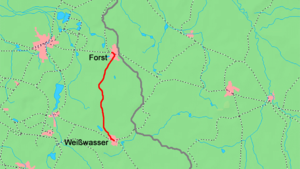Weißwasser – Forst railway line
| Weißwasser (Upper Lusatia) –Forst (Lusatia) | |||||||||||||||||||||||||||||||||||||||||||||||||||||||||||||||||||||||||
|---|---|---|---|---|---|---|---|---|---|---|---|---|---|---|---|---|---|---|---|---|---|---|---|---|---|---|---|---|---|---|---|---|---|---|---|---|---|---|---|---|---|---|---|---|---|---|---|---|---|---|---|---|---|---|---|---|---|---|---|---|---|---|---|---|---|---|---|---|---|---|---|---|---|
| Route number : | 6575 | ||||||||||||||||||||||||||||||||||||||||||||||||||||||||||||||||||||||||
| Course book section (DB) : | 206.46 (1996) | ||||||||||||||||||||||||||||||||||||||||||||||||||||||||||||||||||||||||
| Route length: | 29.910 km | ||||||||||||||||||||||||||||||||||||||||||||||||||||||||||||||||||||||||
| Gauge : | 1435 mm ( standard gauge ) | ||||||||||||||||||||||||||||||||||||||||||||||||||||||||||||||||||||||||
| Route class : | D4 (1996) | ||||||||||||||||||||||||||||||||||||||||||||||||||||||||||||||||||||||||
| Maximum slope : | 13 ‰ | ||||||||||||||||||||||||||||||||||||||||||||||||||||||||||||||||||||||||
| Minimum radius : | 300 m | ||||||||||||||||||||||||||||||||||||||||||||||||||||||||||||||||||||||||
|
|||||||||||||||||||||||||||||||||||||||||||||||||||||||||||||||||||||||||
The Weißwasser – Forst railway was a branch line in Saxony and Brandenburg . The approximately 30-kilometer route connected several industrial sites between Weißwasser and Forst (Lausitz) . In 1996 the line was closed.
history
Weißwasser, under Prussian administration since 1815, was connected to the Berlin-Görlitzer Bahn in 1867 . The members of the committee of interested parties established the following year for the construction of a forest-Weißwasser railway line were repeatedly at odds over the planned route, so that this had to be revised several times and the committee ultimately dissolved.
The committee, which was newly founded in 1880, received approval for the construction of the railway line from the Prussian Ministry for Trade, Industry and Public Works on October 19, 1880. The construction costs, estimated at 1.569 million marks, were to be obtained through the allocation of shares, which soon turned out to be a problem. After the Berlin-Görlitzer Railway was nationalized in 1882, the committee tried to involve the Prussian state in the financing. In 1886 there was a financing and building commitment if the committee members made the necessary land available in return.
Construction management was taken over on April 6, 1887 by the Royal Railway Directorate in Berlin. Preparatory work for construction began on August 22, 1888, and the groundbreaking ceremony took place on August 8 of the following year. The Cottbus Railway Works Office, to which the line was subordinated, monitored the construction.
By 1891 the line and the sidings to numerous coal mines and industrial, mainly glass factories, were built. Due to necessary renovation work at the train stations in Forst and Weißwasser, the construction costs increased to 1.99 million marks.
On September 1, 1891, goods traffic was started, and passenger traffic on October 1.
After German reunification and the associated change of the district of Weißwasser to Saxony, the route was geographically on the outer edge of two federal states. The traffic on it was stopped on September 27, 1996, on December 29, 1998 it was officially shut down, after which some tracks were dismantled. The section from route km 22.906 to Forst was retained as a siding.
In 2011, the part from Forst to the Forster industrial park was put back into operation for the companies located there.
literature
- On the economic development of the Weißwasser / Oberlausitz district in the second half of the 19th century . In: District Office Weißwasser / Oberlausitz (Hrsg.): Local history contributions for the district Weißwasser / Oberlausitz . Weißwasser / Oberlausitz 1991, p. 23 f .
Web links
Individual evidence
- ↑ Beate Möschl: Track 44 moves the Forst logistics center. In: Lausitzer Rundschau . April 29, 2011, accessed January 28, 2014 .
- ↑ Bodo Baumert: Starting signal for Forster logistics center. In: Lausitzer Rundschau. January 28, 2012, accessed January 28, 2014 .
- ↑ Jan Selmons: Green light for private use of platform 44. In: Lausitzer Rundschau. January 27, 2012, accessed January 28, 2014 .


